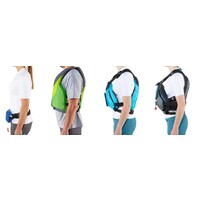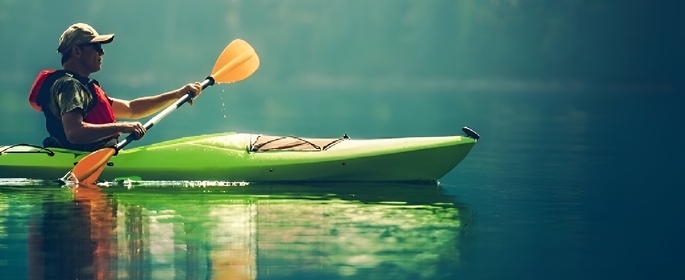Author: PaddleZone Date Posted:31 October 2022

Choosing A PFD – Life Jacket
A personal flotation device – also known as a PFD or Life Jacket – gives you more buoyancy to help you stay afloat in water. A PFD is a truly essential piece of gear for every kayaker, whether fishing, recreational or competitive.
There are a variety of PFD’s available and in most Australian States and Territories, it is mandatory to wear one while paddling. Please check your local requirements if paddling a SUP and always remember, Safety First! Depending on where and when you paddle please also consider a Personal Locator Beacon or PLB.
In Australia, all PFD’s must comply with Australian Standard (AS)4758. All PFD’s available from PaddleZone are AS4758 and this number must have AS4758 printed somewhere on the jacket’s label.
Which PFD for you? At PaddleZone we have two types available standard or inflatable:
Standard PFD’s & Inflatable PFD’s:
The majority of PFD’s on the market are standard, non-inflatable ones. They are foam filled and don't need inflating.
Standard PFD’s
These are PFDs that you’ll see most recreational and fishing kayakers wearing. They look like a vest and rely on flotation material, often foam, to create buoyancy.
Benefits of standard PFD’s:
Low maintenance:
- Other than keeping it clean and dry, ideally out of the sun when not in use, a standard PFD requires very little care. We recommend a rinse with fresh water after every use and drip dry in the shade.
- The PFD should be hung up if possible and not left lying in the sun when drying or being stored. Do not store wet.
- Other than putting it on properly, you don’t need to activate a standard PFD in any way for it to provide flotation.
Versatile: A standard PFD can be used for many different water sports, such as
- Kayaking
- fishing
- canoeing
- and paddle boarding.
Pockets: Most PFD’s provide pockets for storing:
- snacks
- tools
- sunscreen
- emergency gear such as a PLB and
- even a pouch on the back for a water bladder, something you won’t find on inflatable PFDs.
Benefits of inflatable PFD’s:
Inflatable PFD’s use carbon dioxide (CO2) for buoyancy, which makes them lighter and less bulky than a standard PFD.
Inflatable lifejackets are either inflated manually, by pulling a tab, or automatically when they come into contact with water. Excess spray can accidentally activate an auto-inflating life jacket so they are not ‘ideal’ for paddlers.
A person wearing a manual inflatable PFD needs the ability and knowledge to activate it in an emergency.
Inflatable lifejackets are therefore not recommended for:
- children aged under 12 years
- personal watercraft (PWC) drivers and passengers
- anyone being towed.
Manual inflatable PFD’s are not recommended for people who cannot swim.
An annual safety check of the CO2 cylinder is required to ensure safety compliance.
Paddling and PFD Types
Type I PFDs - Level 100
- Have higher levels of buoyancy
- intended for use when the shore is in sight
- not intended for rough conditions
- helps turn you to a face-up position.
A Type II PFD - Level 50
- mainly used in enclosed waters
- intended for people who can swim and are close to the bank or shore or have help close by
- designed to support you in the water, but do not automatically turn you to a face-up position
- made in high-visibility colours to make it easier to see you in the water and increase your chance of rescue.
A Type IlI PFD Level 150
- intended for offshore and rough weather
- helps turn you to a face-up position when unconscious or from a face downward position to a vertical or slightly backward position.
Please talk with our staff about which is the most suitable PFD for you based on where and when you intend to paddle.
Dog PFD’s
Taking your 4-legged friend paddling can be lots of fun for you and the pooch. Your and the dog’s safety is still important though. There are no rules that dogs (or other pets) must wear PFD’s.
You may want to consider investing in one to keep your pet safe. Find one that's a good fit, so your pet does not slip out of it.
- One with a grab handle can be useful to pull them out of the water.
- It should fit snugly so your dog cannot twist, step or swim out of it.
- Look for a low-profile style that will have less potential of catching a snag.
- Look for one with easy-release buckles
PFD Sizing and Fitting
Get the right size:
For adults, your chest size — not your weight — will determine what size PFD you need however paddler weight should be considered. Our sizes start at XSmall up to XXLarge in most models.
To get your chest size, measure the circumference of your chest at its broadest point. Use this number along with the PFD manufacturer’s size recommendations to find the right size for you. You can find sizing information on the PFD product page.
To get the right fit for your PFD, PaddleZone recommend you follow these steps:
With a standard PFD, loosen all the straps, put the PFD on and zip it up. We recommend sitting down ideally in a kayak or on a chair as your body shape changes and you’ll be sitting when kayaking.
Start at the waist and tighten all the straps. If it has shoulder straps, tighten them last. It should feel snug but not restrictive to arm movement or be uncomfortable. Then have someone pull up on the PFD shoulder straps. If it moves up past your mouth or nose, tighten the straps. If it still moves up, the PFD is too large.
A properly sized PFD should be snug and fit comfortably like a glove yet allow you to move freely and not chafe while paddling.
PFD’s range in price from under $80 to over $200
PFD fit tips:
To get the best feel and fit when trying on a PFD, wear the clothes you would while paddling.
- If you’re a kayaker, take note of how the PFD works with the seat if fitted in your kayak. The PFD shouldn’t ride up or feel uncomfortable. Most kayakers find that a short PFD works best.
- The more straps a PFD has, the more adjustments can be made to customize its fit.
- Female-specific PFD’s typically offer a better fit than unisex ones thanks to contoured cups for bust lines and styles made for women’s torso lengths. Check out the Rewa
PFD’s for Kids
There are important sizing and fit differences between an adult PFD and a child's PFD.
Most notably, you use the child’s weight to determine the correct size rather than using a chest measurement like you do for an adult. It is recommended to try a child’s PFD on for size in store to ensure correct fitting.
Children’s life jackets are labelled for size, similar to clothing – Sizes 4-12 for children. To determine which life jacket to buy for your child, you use their clothing size as a guide. Infants PFD’s are available to order, please enquire in store.
PFD Features
Pockets: Most standard, non-inflatable PFDs have pockets on the front. Consider their size and placement and the gear you’d like to stow in them.
Colour: A bright colour improves visibility: remember ‘be bright, be seen’
Tabs: Tabs let you attach a knife, whistle, strobes or other accessories. Look at the number of tabs and their location on the front and back on the PFD.
Reflective tape: This adds visibility in low-light conditions.
Ventilation: If you’re regularly paddling in hot locations, look for a PFD that has built-in vents that allow body heat to escape.
Fishing features: Some PFDs have multiple tool hangers, loops for a rod and a drop-down pocket table for working with lures and flies.


